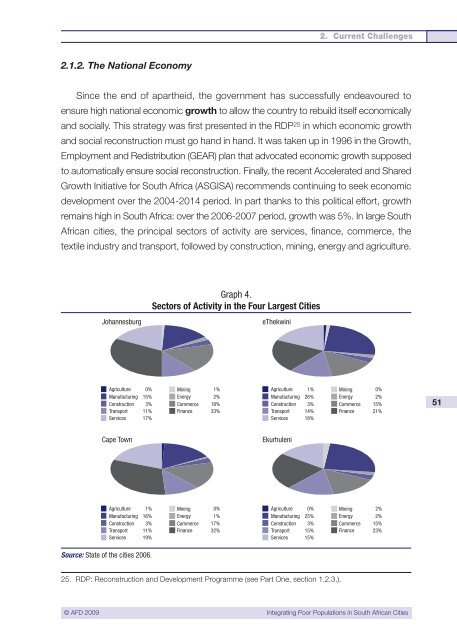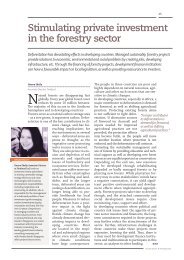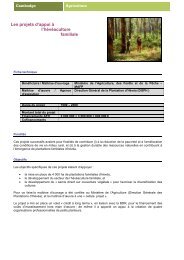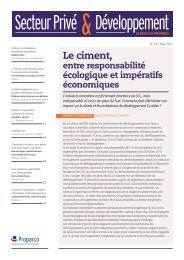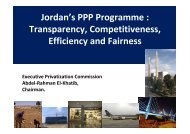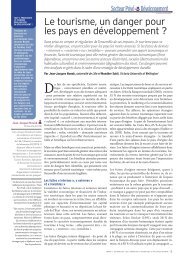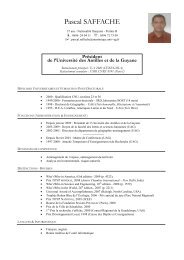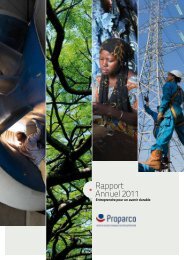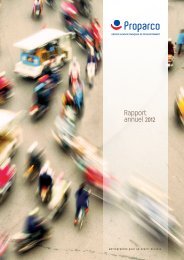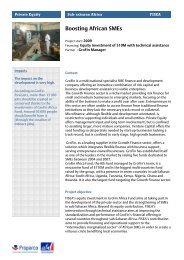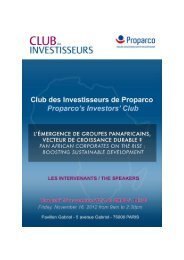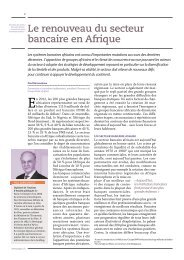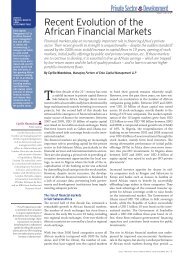Integrating Poor Populations in South African Cities - Agence ...
Integrating Poor Populations in South African Cities - Agence ...
Integrating Poor Populations in South African Cities - Agence ...
Create successful ePaper yourself
Turn your PDF publications into a flip-book with our unique Google optimized e-Paper software.
2. Current Challenges<br />
2.1.2. The National Economy<br />
S<strong>in</strong>ce the end of apartheid, the government has successfully endeavoured to<br />
ensure high national economic growth to allow the country to rebuild itself economically<br />
and socially. This strategy was first presented <strong>in</strong> the RDP 25 <strong>in</strong> which economic growth<br />
and social reconstruction must go hand <strong>in</strong> hand. It was taken up <strong>in</strong> 1996 <strong>in</strong> the Growth,<br />
Employment and Redistribution (GEAR) plan that advocated economic growth supposed<br />
to automatically ensure social reconstruction. F<strong>in</strong>ally, the recent Accelerated and Shared<br />
Growth Initiative for <strong>South</strong> Africa (ASGISA) recommends cont<strong>in</strong>u<strong>in</strong>g to seek economic<br />
development over the 2004-2014 period. In part thanks to this political effort, growth<br />
rema<strong>in</strong>s high <strong>in</strong> <strong>South</strong> Africa: over the 2006-2007 period, growth was 5%. In large <strong>South</strong><br />
<strong>African</strong> cities, the pr<strong>in</strong>cipal sectors of activity are services, f<strong>in</strong>ance, commerce, the<br />
textile <strong>in</strong>dustry and transport, followed by construction, m<strong>in</strong><strong>in</strong>g, energy and agriculture.<br />
Graph 4.<br />
Sectors of Activity <strong>in</strong> the Four Largest <strong>Cities</strong><br />
Johannesburg<br />
eThekw<strong>in</strong>i<br />
Agriculture<br />
Manufactur<strong>in</strong>g<br />
Construction<br />
Transport<br />
Services<br />
0%<br />
15%<br />
3%<br />
11%<br />
17%<br />
M<strong>in</strong><strong>in</strong>g<br />
Energy<br />
Commerce<br />
F<strong>in</strong>ance<br />
1%<br />
2%<br />
18%<br />
33%<br />
Agriculture<br />
Manufactur<strong>in</strong>g<br />
Construction<br />
Transport<br />
Services<br />
1%<br />
26%<br />
3%<br />
14%<br />
18%<br />
M<strong>in</strong><strong>in</strong>g<br />
Energy<br />
Commerce<br />
F<strong>in</strong>ance<br />
0%<br />
2%<br />
15%<br />
21%<br />
51<br />
Cape Town<br />
Ekurhuleni<br />
Agriculture<br />
Manufactur<strong>in</strong>g<br />
Construction<br />
Transport<br />
Services<br />
1%<br />
16%<br />
3%<br />
11%<br />
19%<br />
M<strong>in</strong><strong>in</strong>g<br />
Energy<br />
Commerce<br />
F<strong>in</strong>ance<br />
0%<br />
1%<br />
17%<br />
32%<br />
Agriculture<br />
Manufactur<strong>in</strong>g<br />
Construction<br />
Transport<br />
Services<br />
0%<br />
25%<br />
3%<br />
15%<br />
15%<br />
M<strong>in</strong><strong>in</strong>g<br />
Energy<br />
Commerce<br />
F<strong>in</strong>ance<br />
2%<br />
2%<br />
15%<br />
23%<br />
Source: State of the cities 2006.<br />
25. RDP: Reconstruction and Development Programme (see Part One, section 1.2.3.).<br />
© AFD 2009 <strong>Integrat<strong>in</strong>g</strong> <strong>Poor</strong> <strong>Populations</strong> <strong>in</strong> <strong>South</strong> <strong>African</strong> <strong>Cities</strong>


